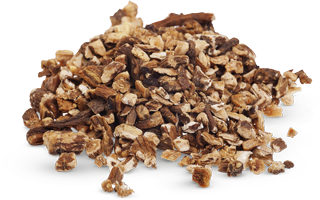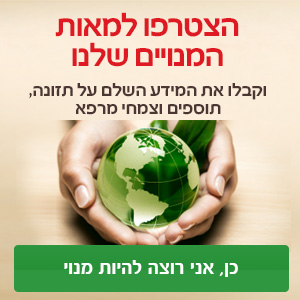חלק הצמח | איכויות | רכיבים פעילים | התוויות | מינונים | רגישות | תופעות לוואי |
מינון יתר | אזהרות | התוויות נגד | רעילות | אינטראקציות | הריון | הנקה
קיימות שתי גרסאות למקור שם הסוג הבוטני (Taraxacum); לפי אחת, השם נגזר מהמילה הערבית-פרסית טרקחקון (מבוטא: tharakhchakon), ולפי האחרת, מיוונית (taraxos = הפרעה, akos = תרופה).
השם העממי של הצמח הינו עיוות של המונח Dent de Lion (׳שן ארי׳, בצרפתית), המתאר את העלים המשוננים והתפרחת הצהובה של הצמח.
שורש שינן קלוי משמש כתחליף קפה נטול קפאין באופן טבעי.
שינן רפואי הינו צמח רב-שנתי עשבוני. מוצאו באירופה ואסיה.
שינן רפואי מותר לשיווק בישראל.
חלק הצמח בשימוש
שורש.
איכויות
טמפרטורה: קריר.
לחות: יבש.
טעם: מריר, מתקתק.
רכיבים פעילים עיקריים
ססקוויטרפנים (eudesmanolides, guaianolides, taraxinic acid), סטרולים (taraxasterol, β-sitosterol, stigmasterol), טריטרפנים (α-amyrin, β-amyrin, taraxol, taraxerol), פנולים (chicoric acid, chlorogenic acid, caffeic acid, p-coumaric acid, ferulic acid ועוד), פלבונואידים (0.3% ממשקל השורש היבש), פוליסכרידים (inulin: בין 2% באביב עד 40% בסתיו), מינרלים (כ-2.45% אשלגן, 0.33% נתרן, 0.33% סידן).
התוויות
דלקות כבד, כבד שומני, עצירות, אבנים בכיס המרה, דלקת בדרכי המרה, דלקת בכיס המרה, דלקת מפרקים שגרונית (RA), פסוריאזיס, סרטן, גאוט, חוסר איזון הורמונלי (PMS, אל וסת, שחלות פוליציסטיות, כאבי ווסת).
מינונים
תמצית נוזלית בריכוז 1:3, 45% אלכוהול – 9-18 מ״ל ביום.
תמצית יבשה – תלוי בריכוז התמצית. מינון המקביל ל- 1.5-4.5 גרם צמח ביום.
מרתח – 6-24 גרם ביום.
בפורמולה – 20-30%.
רגישות
קיימים דיווחים אודות למידע השלם למנויים
בניגוד לאלרגיות אחרות של צמחים ממשפחת המורכבים, למידע השלם למנויים
הססקוויטרפן taraxinic acid, המצוי בצמח, למידע השלם למנויים
תופעות לוואי
עקב השפּעתו למידע השלם למנויים
מינון יתר
לא ידוע על תופעות הנגרמות מנטילת מינון יתר של שורש שינן רפואי בבני אדם(21).
אזהרות וצעדי מנע
אבנים בכיס המרה – למידע השלם למנויים
חומציות קיבה – למידע השלם למנויים
שינויים היסטולוגיים בכבד – למידע השלם למנויים
עודף בילירובין – למידע השלם למנויים
היפרקלמיה – למידע השלם למנויים
התוויות נגד
השימוש בשינן רפואי אסור לאנשים בעלי למידע השלם למנויים
שינן רפואי אסור לשימוש במקרים של למידע השלם למנויים
רעילות
לא ידועה כל רעילות הנגרמת משימוש בשורש שינן רפואי.
בארנבות שצרכו פומית למידע השלם למנויים
תמצית שורש שינן הדגימה רעילות נמוכה ביותר כאשר ניתנה ל למידע השלם למנויים
מדד רעילותLD50: למידע השלם למנויים
תגובות הדדיות עם תרופות / צמחי מרפא / תוספי תזונה
השפעה על חילוף חומרים תרופתי למידע השלם למנויים
תרופות להסדרת קצב לב (Digoxin) למידע השלם למנויים
תרופות מדכאות חיסון (Cyclosporine, Tacrolimus) למידע השלם למנויים
ליתיום (Lithium) למידע השלם למנויים
תרופות להורדת לחץ דם למידע השלם למנויים
תרופות להפחתת רמות הסוכר בדם למידע השלם למנויים
תרופות נוגדות קרישה למידע השלם למנויים
תרופות אנטי-מיקרוביאליות (Ketoconazole, Pentamidine, Trimethoprim) למידע השלם למנויים
הריון
שימוש מוגבל בנשים אינו מעיד על נזק או רעילות לעוברים(18). עם זאת, על פי סוכנות התרופות האירופאית (EMA) מומלץ להימנע מהשימוש בצמח בהריון מפאת חוסר מידע קליני(21).
בירדן, שינן משמש ל למידע השלם למנויים
בחולדות ממין זכר שהואכלו בשינן רפואי (במינון המקביל בבני אדם ל- למידע השלם למנויים
הנקה
שינן רפואי אפשרי לשימוש בתקופה זו(18).
מקורות
- Davies MG, Kersey PJ: Contact Dermatitis 14:256-257, 1986.
- Dawe RS, Green CM, MacLeod TM, et al: Contact Dermatitis 35:109- 110, 1996.
- Fernandez C, Martin-Esteban M, Fiandor A, Pascual C, Lopez Serrano C, Marinez Alzamora F, Diaz Pena JM, Ojeda Casas JA. Analysis of cross-reactivity between sunflower pollen and other pollens of the Compositae family. J Allergy Clin Immunol 1993; 92:660-667.
- Guin JD, Skidmore G: Arch Dermatol 123:500-502, 1987.
- Ingber A: Contact Dermatitis 43:49, 2000.
- Larregue M, et al. Ann Dermatol Venerol . 1978;105:547.
- Hausen BM, Schulz KH. Derm Beruf Umwelt . 1978;26:198.
- Zeller W, de Gols M, Hausen BM. The sensitizing capacity of Compositae plants VI. Guinea pig sensitization experiments with ornamental plants and weeds using different methods. Arch Dermatol Res 1985; 277:28-35.
- Hausen BM, Vieluf IK. Allergiepflanzen/Pflanzenallergene: Handbuch und Atlas der Allergie-induzierenden Wild- und Kulturpflanzen, 2nd edition. Ecomed Verlagsgesellschaft mbH, Landsberg München 1997.
- Mark KA, Brancaccio RR, Soter NA, Cohen DE. Allergic contact and photoallergic contact dermatitis to plant and pesticide allergens. Arch Dermatol 1999; 135:67-70.
- Goulden V, Wilkinson SM. Patch testing for Compositae allergy. Br J Dermatol. 1998 Jun;138(6):1018-21.
- Lovell CR, Rowan M. Dandelion dermatitis. Contact Dermatitis 1991; 25:185-188.
- Jamshieed S, Das S, Sharma MP, Srivastava PS. Difference in in vitro response and esculin content in two populations of Taraxacum officinale Weber. Physiol Mol Biol Plants. 2010 Dec;16(4):353-8. Epub 2010 Dec 7.
- Dutta CP, Ray LPK, Roy DN. Taraxasterol and its derivatives from Cirsium arvense.
- Hausen BM. Taraxinsäure-1‘-O-β-D-glucopyranosid, das Kontaktallergen des Löwenzahns (Taraxacum officinale Wiggers). Dermatosen 1982; 30:51-53.
- Park CM, Youn HJ, Chang HK, Song YS. TOP1 and 2, polysaccharides from Taraxacum officinale, attenuate CCl(4)-induced hepatic damage through the modulation of NF-kappaB and its regulatory mediators. Food Chem Toxicol. 2010 May;48(5):1255-61. Epub 2010 Feb 17.
- Brinker F. Herb Contraindications and Drug Interactions, 4th ed. Sandy (OR): Eclectic Medical Publications; 2010
- Mills S, Bone K. Principles and Practice of Phytotherapy. Churchill Livingstone, Edinburg, 2000
- Bisset NG, Phillipson JD, Czygan FC, Frohne D, Höltzel D, Nagell A, Pfander HJ, Willuhn G, Buff W, (eds). Herbal Drugs and Phytopharmaceuticals: A Handbook for Practice on a Scientific Basis. CRC Press, Boca Raton 1994, 486-489.
- Leung AY; Fosters. Encyclopedia of Common Natural Ingredients . New York: John Wiley and Sons, Inc., 1996;205-207.
- European Medicines Agency. Assessment report on Taraxacum officinale Weber ex Wigg., radix cum herba. Committee on Herbal Medicinal Products (HMPC). 12 November 2009. Available here.
- Mills & Bone - Principles and practice of Phytotherapy. Modern Herbal Medicine, 2ed. Churchill Livingstone, 2013
- Wichtl M (ed.). Herbal Drugs and Phytopharmaceuticals. CRC Press, Boca Raton, 1994
- Blumenthal M (ed.). The Complete German Commission E Monographs. Integrative Medicine Communications, Boston, Mass., 1998.
- Gruenwald J, Brendler T, Jaenicke C (eds.). PDR for Herbal Medicines. Medical Economics Co., Inc., Montvale, NJ, 1998
- Sherman JA (comp.). The Complete Botanical Prescriber, 2nd ed. National College of Naturopathic Medicine, Portland, Ore., 1979
- Felter HW, Lloyd JU. King’s American Dispensatory [1898]. Eclectic Medical Pub., Sandy, Ore., 1993
- Harper-Shove F. Prescriber and Clinical Repertory of Medicinal Herbs. Health Science Press, Rustington, Sussex, Eng., 1952
- Liu X, Han W, Sun D. Treatment of intestinal metaplasia and atypical hyperplasia of gastric mucosa with xiao wei yan powder. Chung Kuo Chung Hsi Chieh Ho Tsa Chih 1992.
- Fang J. Effect of fu-zheng qu-xie on gastric disease infected with Campylobacter pyloridis. Chin J Mod Dev Trad Med 1991.
- Loewenfeld C, Back P. The Complete Book of Herbs and Spices . David E. Charles. London: Seymour, 1974.
- De Smet PAGM et al. (eds.). Adverse Effects of Herb Drugs 2. Springer-Verlag, Berlin, 1993
- Brooks S (ed.). Botanical toxicology. Protocol J. Bot. Med., 1(1):147-158, 1995
- McGuffin M, Hobbs C, Upton R, Goldberg A (ed.). Botanical Safety Handbook. CRC Press, Boca Raton, 1997
- Lust J. The Herb Book. Bantam Books, New York, 1974
- Bohm K. Studies on the choleretic action of some drugs. Arzneim.-Forsch., 9:376-378, 1959
- Akhtar MS, Khan QM, Khaliq T.Effects of Portulaca oleracaea (kulfa) and Taraxacum officinale (dhudhal) in normoglycaemic and alloxan-treated hyperglycaemic rabbits. J Pakistan Med Assoc 1985; 35:207-210.
- Tita B, Bello U, Faccendini P, Bartolini R, Bolle P. Taraxacum officinale W.: pharmacological effect of ethanol extract. Pharmacol Res 1993; 27:23-24.
- Rácz-Kotilla E, Rácz G, Solomon A. The action of Taraxacum officinale extracts on the body weight and diuresis of laboratory animals. Planta Med 1974; 26:212-217.
- Maliakal PP, Wanwimolrum S. Effect of herbal teas on hepatic drug metabolizing enzymes in rats. J. Pharm. Pharmacol., 53:1323-1329, 2001
- Brown R. Potential interactions of herbal medicines with antipsychotics, antidepressants and hypnotics. Eur. J. Herb. Med., 3(2):25-28, 1997
- Harkness R, Bratman S. Mosby's Handbook of Drug-Herb and Drug-Supplement Interactions. Mosby, St. Louis London Philadelphia Sydney Toronto, 2003; 163.
- Goksu E, Eken C, Karadeniz O, Kucukyilmaz O. First report of hypoglycemia secondary to dandelion (Taraxacum officinale) ingestion. Am J Emerg Med. 2010 Jan;28(1):111.e1-2.
- Cho SY, Park JY, Park EM, et al. Alternation of hepatic antioxidant enzyme activities and lipid profile in streptozotocin-induced diabetic rats by supplementation of dandelion water extract. Clin Chim Acta 2002;317:109-17.
- Onal S, Timur S, Okutucu B, Zihnioğlu F. Inhibition of alpha- glucosidase by aqueous extracts of some potent antidiabetic medicinal herbs. Prep Biochem Biotechnol 2005;35:29-36.
- Barnes J, Anderson LA, Phillipson JD. Herbal Medicines. London: Pharmaceutical Press, 2002.
- Newall CA, Anderson LA, Phillipson JD, eds. Herbal Medicines: A Guide for Health-Care Professionals . London: Pharmaceutical Press; 1996.
- Saulnier P, Crosbie L, Duttaroy AK. Inhibitory effect of aqueous extracts of some herbs on human platelet aggregation in vitro. Platelets 2005; 8:469-473.
- Modaresi M, Resalatpour N. The Effect of Taraxacum officinale Hydroalcoholic Extract on Blood Cells in Mice. Adv Hematol. 2012;2012:653412. Epub 2012 Jul 12.
- Neef H, Cilli F, Declerck PJ, Laekeman G. Platelet antiaggregating activity of Taraxacum officinale Weber. Phytother Res 1996; 10:138-140.
- Tahtamouni LH, Alqurna NM, Al-Hudhud MY, Al-Hajj HA. Dandelion (Taraxacum officinale) decreases male rat fertility in vivo. J Ethnopharmacol. 2011 Apr 26;135(1):102-9. Epub 2011 Feb 24.

דוגמא למונוגרף מלא
לרכישת מנוי |
כניסת מנויים






